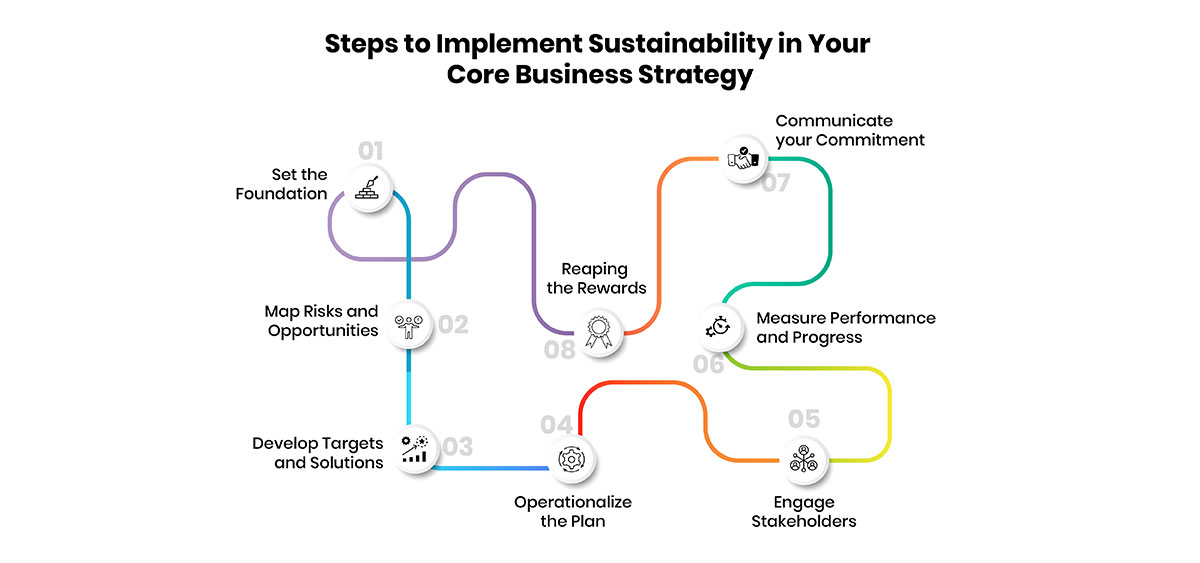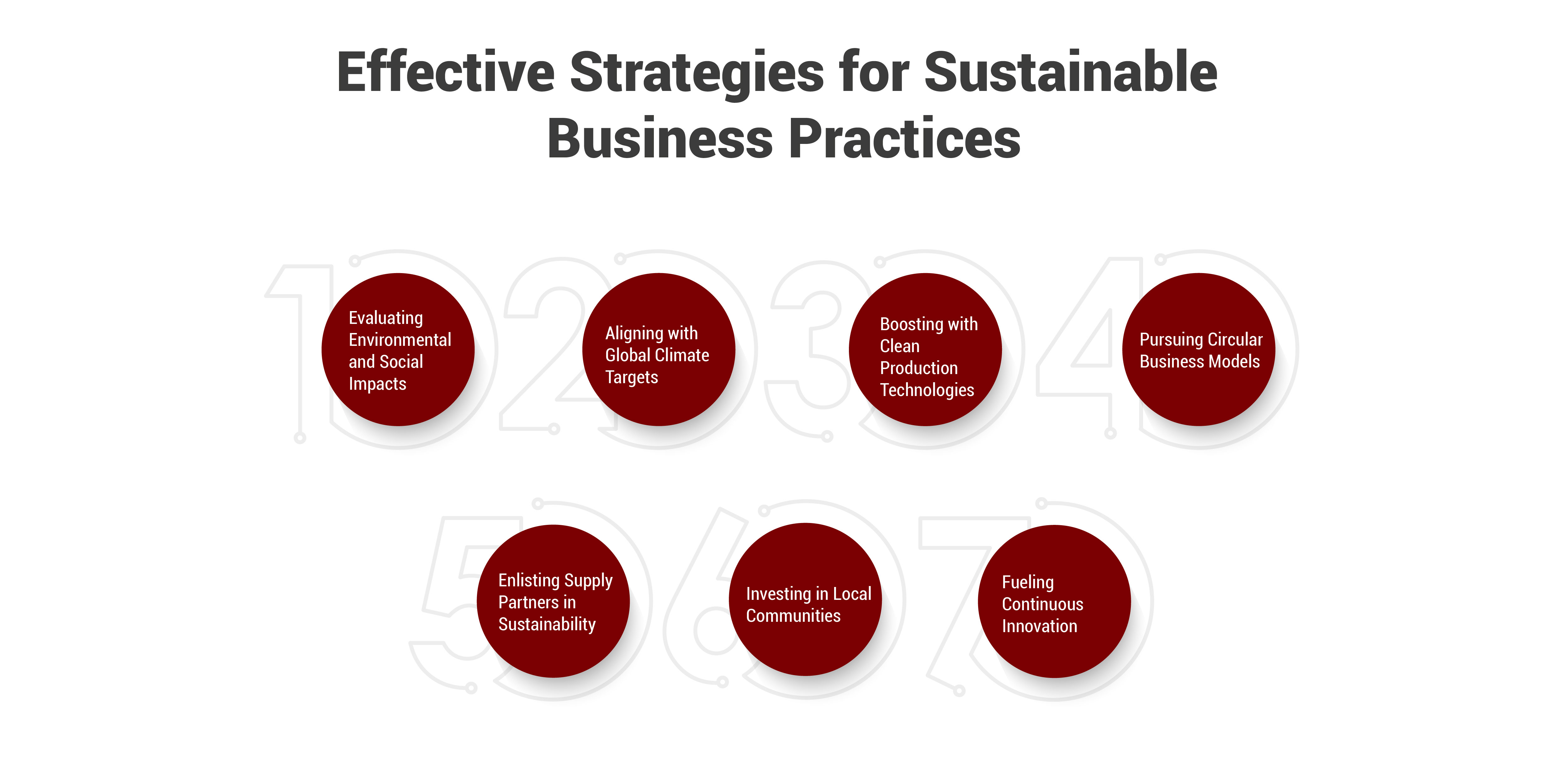A Roadmap for Embedding Sustainability in Your Core Business Strategy
 June 28, 2024
June 28, 2024
Businesses today can no longer afford to ignore sustainability. With climate change intensifying and environmental regulations tightening, sustainability has evolved from an optional corporate social responsibility (CSR) initiative to a business imperative. According to a report by Boston Consulting Group, sustainability will account for $7 trillion in new market opportunities over the next decade.
Building a future-forward business means embedding sustainability at the сore of your strategic planning. But how exactly do you develop an impactful sustainable business strategy? In this article, you’ll learn the step-by-step process of developing an effective, sustainable business strategy through identifying material ESG issues, exploring risks and opportunities, and activating solutions across your value chain. By weaving environmental and social values into your DNA, you can future-proof your model, engage stakeholders, and unlock new profit pools. Let’s get started!
Growing Importance and Consumer Demand for Sustainability
Research shows that consumers, especially younger generations, now make purchasing decisions based not just on price and quality but also on whether the company and product are sustainable. A recent PwC survey found that 70% of global consumers are willing to pay 9.4% more for sustainable offerings. Furthermore, investments in sustainability have been correlated to increased competitive advantages such as improved brand value, enhanced productivity, and reduced costs. As sustainability turns from a differentiator to a license to compete, establishing sustainable practices is necessary for businesses to remain relevant and successful.
Why Should Businesses Integrate Sustainability Strategies into Their Core Operations?
While early sustainability efforts from some companies focused on piecemeal initiatives like recycling programs and carbon offsetting, embedding sustainability comprehensively across business functions is now key. Sustainability needs to be ingrained in long-term strategies, day-to-day operations, product innovation, supply chain management, and stakeholder engagement practices to future-proof operations from emerging risks and tap new opportunities.
A holistic approach integrating economic, social, and environmental factors is required to advance sustainability systemically rather than surface-level changes. Furthermore, with increasing regulation and mandatory reporting on ESG factors, strategies for sustainability have become table stakes for companies looking to enhance resilience and stakeholder trust.
What are the Key Elements of a Sustainable Business Model?
A truly sustainable business model incorporates creating shared value, Circular economy principles, renewable energy sourcing, and other innovative solutions to address systemic challenges while generating long-term profits. Key elements of such a model include stakeholder capitalism, where a company prioritizes the interests of workers, communities, ecosystems, and society alongside shareholders. It means localizing supply chains and “looping” resources and materials through recycling and reusing to minimize waste.
A sustainable model promotes diversity, equity, and inclusion within the workforce and partners with suppliers compliant with social and environmental standards. It adopts cleaner production processes, offsets carbon emissions, and relies on renewable rather than finite resources to reduce its environmental footprint over time. Ultimately, a sustainable model is future-fit, ethically governed, and mitigates risk by proactively solving large-scale problems rather than exacerbating them through core operations.
How Can Businesses Implement Sustainability?
To truly institutionalize sustainability, businesses need to mainstream associated considerations into routine management practices rather than treating it as a separate function. For instance, finance departments can analyze sustainability-linked risks and opportunities as part of investment appraisals and due diligence procedures. Procurement teams must build ESG compliance into supplier selection criteria and contracts. Designing products with an end-of-life mindset and using renewable, recycled, or sustainably sourced materials improves their sustainability profile.
Raising sustainability awareness across departments ensures functions are empowered and accountable towards agreed goals. Embedding metrics for resource use, emissions, worker safety, inclusion, etc., into performance reviews provides transparency in execution. Continuous capacity building and communication keep employees invested as change ambassadors within and outside the company.
Steps to Implement Sustainability in Your Core Business Strategy
Here are the steps to implement sustainability in your core business strategy:

-
1. Set the Foundation
The first step is assessing where your business stands today regarding sustainability. Evaluate your impacts, dependencies, and performance across environmental, social, and governance issues. Tap cross-functional expertise - production can weigh in on emissions sources while HR offers insight into diversity. Benchmark against industry peers, too, through sustainability reports. This materiality assessment identifies the ESG factors most vital to your long-term success.
Focusing on solutions here maximizes your ability to mitigate risks and realize opportunities. For example, if severe weather disrupts supply due to a lack of adaptation efforts, more resilient sourcing should be pursued. Make the rationale for prioritizing certain issues crystal clear internally and externally.
-
2. Map Risks and Opportunities
With material issues identified, explore how each might play out over the coming years. Rising carbon prices could impact input costs while investing in cleantech might yield competitive advantages. Scenario planning helps envision potential paths, whether sea level rise threatening facilities or talent demanding more purposeful employers.
Map your value chain to expose where vulnerabilities and incentives lie. Perhaps protecting ecosystems near growers strengthens future supply. Or engaging communities around plants fosters trust to test novel products. Get savvy about evolving regulations, too - adjusting ahead of bans preserves market access. Your strategy must show how tackling these dynamics strategically positions your business for sustainable success.
-
3. Develop Targets and Solutions
Now, it’s time to translate high-level insights into an executable roadmap. For priority issues, establish targets with owners, timelines, and metrics for measuring progress. Make ambitions significant yet realistic based on your context. Consider both quantitative goals like slashing emissions intensity as well as qualitative aims to bolster diversity, equity, and inclusion.
Outline initiatives across functions that will help hit targets cost-effectively. Procurement might source renewable energy, or R&D could develop new packaging. Marketing could promote transparency while facilities test zero-waste strategies. Pilot interventions where possible, then scale solutions earning high returns socially and financially. Budgeting demonstrates the seriousness and importance placed on sustainability.
-
4. Operationalize the Plan
To truly integrate sustainability, strategies must permeate daily work rather than existing solely on paper. Cascade targets and ownership downward, so the C-suite vision aligns with the frontlines. Cross-train employees on sustainability principles and skills like life-cycle assessment.
Embed responsibility into job descriptions and performance reviews so the sustainable mindset becomes second nature. Streamline tracking and reporting procedures to monitor key indicators efficiently. Leverage internal communications channels and forums for exchange between functions and levels. An empowered, informed workforce maximizes your ability to execute the plan seamlessly across complex operations.
-
5. Engage Stakeholders
No business is an island. Gaining insight and buy-in from those impacted by your activities strengthens strategy legitimacy and impact. Regularly convening stakeholders, from investors to suppliers, fosters collaboration on shared challenges. Outline your direction and solicit qualitative and quantitative feedback to refine priorities and initiatives over time.
Explaining your journey helps build trust and reassure audiences that meaningful progress lies ahead. Channels like conferences, site tours, and advisory councils deepen relationships. Partnerships emerge from stakeholder insights, too - teaming up to restore habitats or source inclusive materials amplifies collective influence. A two-way dialogue embeds sustainability at the heart of your business model.
-
6. Measure Performance and Progress
With initiatives unfolding, track key performance indicators (KPIs) against targets to adjust course as needed. Both lagging metrics reporting past impacts and leading indicators forecasting future trajectories offer full visibility. Progress reports distribute results to managers overseeing change as well as external audiences.
Quantitative stats illuminate hotspots for optimization while qualitative consultations enrich understanding of impacts. Regular reviews evaluate whether sufficient resources and senior support exist, revisiting materiality and risk analyses periodically. External assurance lends credibility to disclosures, boosting your reputation as a trusted operator. Benchmarking also reveals competitive gaps for continuous improvement.
-
7. Communicate your Commitment
Publicly demonstrating accountability and leadership maintains momentum. Annual reports, dedicated sustainability reports, and impact summaries highlight efforts and results for all stakeholders. Creative storytelling showcases sustainability woven into your DNA, from employee wellness to innovative products and supply chain resilience.
Social media campaigns increase visibility while traditional PR maintains a profile. Awards applications recognize sustainability talents and accomplishments industry-wide. Participating in sectoral initiatives displays collective problem-solving beyond a single operation. Align messaging across functions to project a cohesive narrative of your future-focused identity. Transparency builds trust and engagement critical to long-term viability.
-
8. Reaping the Rewards
Developing a robust, sustainable business strategy is no short-term fix, but it reaps major benefits. Engaged, values-driven employees strengthen retention and well-being. Risk mitigation protects from resource constraints and disruptions, enhancing continuity. New revenue streams emerge from products meeting sustainability demands.
Cost savings materialize through efficiency initiatives like renewable sourcing or zero-waste hauling. Brand desirability surges, appealing to conscious consumers and investors prioritizing ESG performance. Regulators recognize proactive industries easing future compliance burdens. Longevity results from integrating sustainability systematically at every level. By future-proofing your model today, a brighter tomorrow blossoms.
Effective Strategies for Sustainable Business Practices
The following are some successful strategies adopted by leading sustainable companies:

-
Evaluating Environmental and Social Impacts
A core strategy that leading sustainable companies implement is carrying out life cycle assessments to thoroughly evaluate a product or service’s environmental and social impacts from inception to completion. By taking a holistic view, starting from material sourcing, production processes, distribution, usage, and eventual disposal or recycling, companies can pinpoint hotspots where emissions, waste, or inefficiencies are highest. This allows them to systematically redesign operations or switch to alternative materials and technologies that lessen burdens at various stages of the life cycle.
-
Aligning with Global Climate Targets
Another approach adopted is establishing science-based targets to help align climate actions with the global reductions required by 2030. Setting ambitious, verifiable emissions reduction goals approved by the Science Based Targets initiative gets companies to deeply cut emissions across their value chains in line with limiting global warming to 1.5°C. It compels them to drastically lower carbon footprints from direct operations and energy use as well as indirect sources such as purchased goods and services, transportation, and distribution activities.
-
Boosting with Clean Production Technologies
Sustainable enterprises additionally opt for clean production technologies that beef up efficiencies while scaling back environmental footprints. For example, they will invest in renewable energy systems like solar panels and wind turbines to power facilities and switch energy needs away from fossil fuels. Non-toxic chemicals and processing methods are incorporated in place of hazardous substances. Energy-efficient equipment, buildings, and vehicles are procured to decrease electricity and fuel consumption. All these moves help companies break away from carbon-intensive and polluting operations.
-
Pursuing Circular Business Models
Forward-thinking businesses also pursue circular business models with the goal of recovering and regenerating resources at the end of product life cycles, so materials are kept in continual use. By designing products for disassembly, repair, reuse, and high-quality recycling from the outset, companies ensure components and materials retain value for as long as they are viable instead of being disposed of as waste. Take-back and resale programs boost resource recovery while closing material loops fosters sustainable value creation.
-
Enlisting Supply Partners in Sustainability
Leading firms, moreover, deploy sustainability performance right through their supply chains by getting suppliers, vendors, and business partners to meet responsible sourcing and production standards. Strict audits and certification requirements are put in place for aspects such as ethical labor practices, reductions in carbon emissions and water usage as well as bans on unstable chemicals and raw materials sourced from protected lands. This allows companies to uphold integrity across their value networks and brands.
-
Investing in Local Communities
Part of long-term strategic resilience is preserving natural capital by protecting the local communities and environments in which enterprises are based. Top sustainable organizations make dedicated investments in community projects related to environmental conservation, education, healthcare, infrastructure, and disaster relief. Such social investments alleviate risks to the continuity of operations from resource depletion or conflicts while building goodwill. Local hiring and equitable pay strengthen stakeholder relationships as well.
-
Fueling Continuous Innovation
Finally, to future-proof operations amid constant disruption, sustainable innovators channel resources into R&D focused on developing more eco-friendly products, technologies, and solutions. Innovation roadmaps are drawn up with an eye on trends like the circular economy, clean tech, climate change solutions, AI applications, and new business models. This continuous improvement and bringing of next-generation offerings to market guarantees companies remain leaders in their fields for decades ahead and stay on top of growing client expectations for sustainability.
Conclusion
Embedding sustainability in core operations and long-term planning is now mission-critical for future-proofing businesses amid global crises. While implementation requires comprehensive organizational transformation, the opportunities for risk mitigation, cost efficiencies, innovation, and social license to operate far outweigh short-term costs.
With persistent commitment and review, sustainability can be fully institutionalized to strategically guide business decisions on an ongoing basis. This delivers a sustainable competitive advantage and future-focused resilience that future generations will depend on companies providing. Corporates must rise to their responsibilities in co-creating a greener, more equitable world through conscientious stewardship of economic and social progress.



